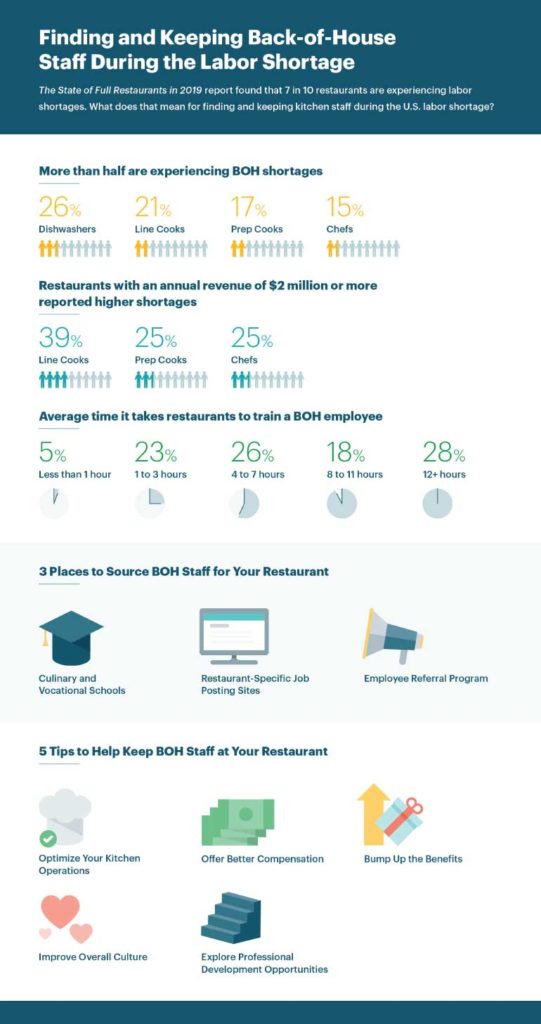The kitchen is the heart of any restaurant, which means you can’t run a successful venue without adequate kitchen staffing.
The challenge is, the restaurant industry has been struggling with a shortage of chefs and other back of house staff for several years now.
Back in 2019, TouchBistro’s Annual Industry Report found that seven in 10 restaurants in the U.S. were experiencing a labor shortage. This report also revealed that the labor shortage was specific to back of house staff, with more than half (52%) of full service restaurants experiencing kitchen staffing shortages. Worse still, it seemed that the higher the annual revenue for a restaurant, the more they struggled with labor shortage across multiple roles. For restaurants with an annual revenue of $2 million or more, 39% reported a line cook shortage, and 25% said they didn’t have enough prep cooks and chefs.
And the problem has only gotten worse in the wake of the pandemic. As of June 2021, the Bureau of Labor Statistics reported that the restaurant industry was still 1.5 million jobs – or 12% – short of pre-pandemic levels. And like previous worker shortages, the problem is more pronounced among back of house staff. In fact, a recent survey by a restaurant-staffing firm found that a whopping 25% of back of house restaurant workers have left the industry entirely.
While these stats put real numbers on a grim reality you might already be facing, rest assured there are strategies you can put in place to help you deal with kitchen staffing issues caused by the back of house labor shortage.
In this post, you’ll learn:
- Why it’s important to find the best kitchen staff and keep them
- 3 places to source back of house staff for your restaurant
- 5 kitchen staffing tips to help you retain back of house staff
Why It’s Important to Find the Best and Keep the Best
Why is kitchen staffing so crucial to the success of your restaurant? It’s all about the bottom line.
Finding and keeping the best back of house staff is critical to your restaurant’s success for two reasons:
- You need to keep your operating costs low – so you stay in business.
- You need to keep your operations running smoothly – also so you stay in business.
While high restaurant turnover rates have always been a struggle in this industry, the labor shortage makes them so much worse. You end up spending both time and money training new staff that may have a shorter shelf life than that case of tilapia you ordered last week.
Our 2019 restaurants report found that back of house training ranges from less than one hour (5% of restaurants) to more than 12 hours (28% of restaurants). For those with 120 seats or more, 51% of restaurants train their kitchen staff for more than 12 hours.
When you invest that much in an employee, you need to be pretty sure they’re a) the right fit and b) they’ll stay longer than the time it takes to get them up to speed.
Beyond operating costs, finding and keeping the best kitchen staff is also about how your kitchen operates. Being short-staffed – or not staffed properly – means you can’t focus on maximum efficiency in the kitchen for prep or line cooks.
This makes reducing labor costs harder – especially as minimum wage continues to rise. It can also slow down your restaurant’s service and prevent you from delivering the type of customer experience you’re known for. Even worse, inadequate kitchen staffing can have an effect on the overall morale of your team. There’s more pressure on the staff members trying to hold the back of house together and more reasons for them to jump ship.
Keeping your kitchen running smoothly and your costs down are two business goals to keep in mind when developing strategies for finding and keeping the best back of house restaurant staffing.

3 Places to Source Back of House Staff for Your Restaurant
The current kitchen staffing shortage requires you to invest more time and resources into your search for back of house staff – especially chefs. Gone are the days when you could just slap a hiring sign in your window and the talented masses would come to you. You’ve got to be strategic, creative, and have a multi-channel approach (i.e. don’t put all your eggs in one recruitment technique). You’ve got to find where the kitchen talent is hiding.
NOTE: Even when you don’t have open kitchen roles, it’s always a good idea to be actively looking for talent. Make connections that will fill your pipeline with potential candidates you can hire when the inevitable turnover happens or a chef shortage strikes.
Here are a few suggestions to help get your search started.

Learn how to hire, train, schedule, and retain restaurant staff.
1. Culinary and Vocational Schools
Culinary schools and vocational programs centered around hospitality are great places to recruit employees for back of house jobs. Students are looking to gain more knowledge and experience in their chosen field. Though their availability may be part-time or weekends only while in school, they will be seeking full-time employment upon graduation.
Whether you approach program administration or advertise directly through on-campus job fairs or student boards (digital or print), make sure to emphasize what you’re willing to offer beyond just the job description:
- Flexibility with scheduling
- An effective learning environment (not just a way to make some extra cash)
- Promotion opportunities
2. Restaurant-Specific Job Posting Sites
Maybe you have the best job posting for a line cook on this side of the Atlantic. But how are potential candidates going to see it?
Beyond advertising on your restaurant’s website, it’s a good idea to look at restaurant-specific job boards – rather than just a general job board like Indeed or Craigslist – especially if you’re looking for some level of experience for back of house jobs.
Some of the top restaurant or hospitality job boards for kitchen staff include:
- Chef Crossing: Job aggregator that researches, locates, and organizes culinary jobs from a variety of platforms where you can submit a job post or pay for a “featured” job post.
- Culinary Agents: Job site for restaurants in over 30 U.S. cities, with a charge per job you post ($49) or for a few posts per month ($100 for 4 job posts a month).
- RestoJobs: Based out of Quebec, this Canadian job board helps restaurant owners reach thousands of students, graduates and qualified professionals for a small fee ($20 for a 30 day plan).
- iHireChefs: Job site with a large pool of cities and town to search in, specific to restaurants (vs. hospitality in general) – while the talent pool is larger, so are the fees ($299+ per month for one job post; $399+ per month for three job posts; $699+ per month for 10 job posts)
- Poached Jobs: Job site with a focus on larger cities like New York, L.A., Chicago, Boston, Portland, and more, with a charge per job you post ($35 to $49).
- RestaurantZone: Email database and job board for restaurant workers with ongoing subscription options (from $199) or pay per post.
3. Employee Referral Program
An employee referral program is a way of finding new, qualified staff by asking for recommendations from existing staff. While this type of networking can happen naturally, having a formal structure (and incentive!) in place increases the frequency and quality of referrals, which helps you find kitchen staff faster (and may prevent a cook shortage in your restaurant).

So what type of incentives should you offer?
Some of the most common employee referral incentives include:
- Cash (there’s a reason it’s king)
- Gift certificate to their favorite store
- A paid day off
- Tickets to a game, concert, or show (for them, plus the hired referral)
- Social media recognition
- Weekend trips
- Professional development opportunities (courses, classes, events)
- Major holidays off (Christmas Eve, New Years, etc.)
- Free in-house meals
It’s also common to have other eligibility requirements, like the referred employee must stay with the restaurant for 90 days or longer before the referrer gets to collect the bonus.
If you do set up a formal employee referral program, make sure you get the word out. Announce it at an all-team huddle, send out a group email, or use your staff management and scheduling software to communicate all the details of the program.
BONUS: If someone does cash in on the incentive, make sure the word spreads through the restaurant, too. There’s nothing like seeing someone else get rewarded to drive others toward the same goal.
5 Kitchen Staffing Tips to Help Keep Back of House Staff
Finding new employees is part of the kitchen staffing struggle. Keeping them is the other.
With so many back of house jobs available and not enough workers, it’s easy for a dollar more an hour or better benefits to steal someone away – someone you needed to make your kitchen run smoothly.
Getting strategic about employee retention is one of the best ways to control back-of-house labor costs and increase employee productivity, since happy employees are more productive – by up to 20%.
Plus, a restaurant with a reputation for keeping the talent it finds will be that much more appealing to new hires in the first place.
Here are five tips to help you keep the talented back-of-house staff you do have.
1. Optimize Your Kitchen Operations
Is your kitchen running as efficiently as possible? Observe what’s happening during a busy shift, taking note of strengths and areas that could be improved. Maybe it’s an issue with your commercial kitchen layout, the overall prep time, an inefficient kitchen order system, or communication with the front of house.

Map out how long each kitchen process takes and where you experience the most bottlenecks. Then look for solutions to speed up each process and improve the flow from one to the next. That could involve a new way of organizing cooks at your food stations, additional technology like a kitchen display system (KDS), or more efficient equipment.
The benefit of optimizing your kitchen operations – beyond the impact on service – is creating a less stressful, more enjoyable place to work for your back-of-house staff that will keep them at your restaurant longer.
2. Offer Better Compensation
This one’s pretty straightforward.
Our report found that two-thirds of full service restaurants use higher wages to attract top talent.
If this is something you can afford to do, amazing. But we’re not talking about just hourly wage here.
Revisit your tip pooling policy and see if there’s a way to increase the distribution between back-of-house workers that don’t receive tips directly but work just as hard as those who do.

Learn how to hire, train, schedule, and retain restaurant staff.
3. Bump Up The Benefits
Another part of compensation for your kitchen staff is the benefits package. Our State of Restaurants report found that benefits came in second to higher wages as a way to attract the best talent.
For your full-time employees (30 hours per week or more), consider offering health benefits like:
- Medical
- Dental
- Disability
- Paid time off
Even adding shift meals, transportation subsidies, and employee activities can go a long way to making the overall package you offer to both existing and new employees that much more attractive.
4. Improve Overall Culture
Coming in a close third in our report for ways to attract talent, just behind higher wages and benefits, was improving workplace culture – 41% of respondents said this was one of their regular strategies.
These days, there’s a greater emphasis on work-life balance, which means your back of house staff likely want more predictable hours and stability.
But – here’s a crazy thought – why don’t you go ahead and ask them what they want?
Conducting a quick, anonymous survey can help you take the temperature of your workplace culture – what people like, what people don’t – and provide a goldmine of ideas to improve it. You might even want to separate front-of-house from back-of-house surveys, so you can more easily see the similarities and where the two groups have different needs.
Make changes based on employee suggestions and then send out the same survey a few months later. Compare the results. Not only will the changes help improve your workplace culture, but so will the sense that management is actually listening to them.
5. Explore Professional Development Opportunities
Offering professional development opportunities – like mentorship, classes, skills training – is another way to keep kitchen staff at your restaurant and prevent a major chef shortage.
Not only does your business benefit from the additional skills learned, but the extra investment helps employees see your restaurant as a long-term plan, a place where they can grow. And, the more roots they have, the less likely they are to leave for that extra dollar from the competition.
Take the chain Chipotle, for example. Career development is a big part of Chipotle’s hiring process and – some suggest – their not-so-secret to success. They hire almost exclusively for the lowest-paid job (“team member”) and only promote from within. Managers are incentivized with bonuses to promote their employees, motivating them to develop and mentor their employees to the next level.
Could you set up something similar for your kitchen staff?
You can’t control how long the kitchen staffing crisis will last or what restaurant roles it will affect the most. But you can control your approach to finding and keeping the best back of house staff out there.
A conscious, multi-approach strategy that uses the most of your available resources will set you up to thrive during this labor shortage – and on the other side of it.

Learn how to hire, train, schedule, and retain restaurant staff.
Download your free employee handbook template
Sign up for our free weekly TouchBistro Newsletter







